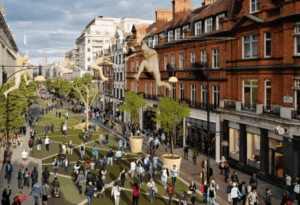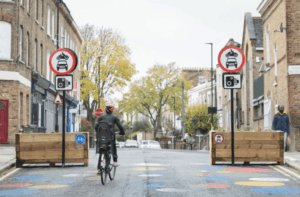The Mayor of London, Sadiq Khan, has pledged to continue his pioneering work to clean up the capital’s toxic air as new City Hall data shows major improvements in London’s air quality since 2016 and further significant improvements forecast for 2025 and 2030.
Thanks to the ambitious policies introduced by Sadiq over the last seven years, Londoners have experienced significant reductions in both nitrogen dioxide (NO2) and fine particulate matter (PM2.5) pollution.
The data was commissioned in 2019, A year before the London-wide ULEZ expansion was confirmed. Projections therefore do not take into account the policy impacts of expansion on emissions reduction.
The WHO clean air targets reflect the best available health evidence and are now recognised globally as the targets that should be met to protect public health.
Air pollution is linked to increased health risks, including the stunted growth of lungs in children and the worsening of chronic illnesses, such as asthma, lung and heart disease, and dementia in adults.
These serious health consequences underline the need for further action to tackle emissions from both transport and non-transport sources of air pollution. That’s why the Mayor is expanding the ULEZ London-wide in August to ensure five million more Londoners can breathe cleaner air.
The newly published London Atmospheric Emissions Inventory (LAEI) forecasts provide the clearest picture yet of the impact of the Mayor’s policies and the sources that need to be tackled to reach World Health Organization (WHO) clean air targets by 2030. The data shows total NOx emissions in Greater London reduced by 18 per cent between 2016 and 2019 and are forecast to reduce by a further of 31 per cent by 2025 and 44 per cent by 2030 (compared to 2019).
The data underlines the need for additional action as all schools, care homes and hospitals are located in areas that are forecast to exceed WHO recommended guidelines until at least 2030. There has, however, been progress in meeting the existing legal limits, with the data showing that all London schools are located in areas that will meet the UK Government-set legal limits for NO2 by 2025, up from 76 per cent of schools in 2016 and 98.5 per cent in 2019. [3] All London hospitals will also meet the legal limits for NO2 by 2025. Since 2019, all care homes in London have been within the legal limits for NO2.
The Mayor has committed to bring levels of fine particulate matter (PM2.5) in London down to 10ug/m3 by 2030 – a decade before the new UK legal deadline – which current data reveals is also achievable.
These improvements in air pollution confirm that schemes introduced by the Mayor, including the world’s first Ultra Low Emission Zone, new planning policies, such as the Air Quality Positive and Neutral guidelines, making London’s bus and taxi fleets greener, and the installation of electric vehicle charging points, are achieving their intended purpose – to create a greener, safer, cleaner London for all.
However, there is still much more work to be done before London meets legal and safer pollution limits and all Londoners can breathe clean air.
The Mayor of London, Sadiq Khan, said: “This new data shows that we have every reason to be hopeful about the future of our city if we continue to take bold action. The impressive rate of reductions in harmful pollution since 2016 highlights that world-leading policies, like ULEZ, are helping us to deliver a greener, safer, cleaner London.
“But the data also makes clear we have some way to go. I’m determined to build on the progress made and deliver the bold action needed to ensure all Londoners are able to breathe clean air, starting with the expansion of the Ultra Low Emission Zone London-wide this August.”
Professor Frank Kelly, Head of the Environmental Research Group (a global centre dedicated to air pollution research) at Imperial College London, said ‘The latest update of the LAEI delivers valuable insight into how emissions of ill health-related air pollutants have changed in London and, importantly, how we expect them to change over the next seven years. With the much stricter air quality guidelines introduced by the WHO in 2021, significantly more action is needed to protect the health of Londoners. The LAEI will certainly contribute, by helping London Boroughs appreciate, and hopefully introduce, the most effective measures to clean up our air’.
Larissa Lockwood, Director of Clean Air at Global Action Plan, the environmental charity behind Clean Air Day, said ‘As both a campaigner and a parent, it is deeply concerning to see that Londoners will not be breathing clean air in the near future and that our health continues to be put at risk from harmful air pollutants. The recent reductions in air pollution are encouraging and show that this is a problem we can solve. We now need to do more and quicker – this includes cleaner vehicles on the roads, fewer vehicles on the roads and an end to the unnecessary use of wood burners’




















